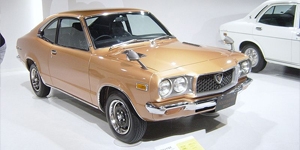

With a power-to-weight ratio of 10.9 kg per kW compared to the RX-2's 9.9 kg per kW, the RX-3 was slower. Performance-wise the 10A RX-3 wasn't able to match the RX-2 with 12A. Fortunately price didn't play an overwhelming role in RX-3 sales - the rotary engine was Mazda's main selling point. Comparing the coupe in price, Mazda priced the RX-3 against cars like the 190-hp Holden Torana GTR XU-1 ($3455), the 144-hp Ford Capri GT V6 ($3490), and the 218-hp Valiant RT Charger ($3395). The manual sedan cost AUS$3299 (3-speed automatic transmission was a $341 option) and the coupe AUS$3479. All Series 1 RX-3s came with the 982cc 10A.

The coupe carried an optional body stripe, clock, rear defogger and the centre console/high armrest and collapsible steering column. Australian-model RX-3s came in two bodies - the Deluxe sedan and the Super Deluxe coupe.Įquipment differences between the RX-3 Deluxe sedan and the Super Deluxe coupe were many. Not only missing out on the wagon but the 130hp 12A. The Australian market (and New Zealand) was less fortunate. Following the 'peoples rotary' theory, the first rotary station wagon was made available in Japan and in the US. With the addition of three new body styles, the rotary line up now totalled nine choices internationally. March of 1972, the RX-3 was released in Australia - seven months after Mazda Japan had launched the RX-3 and the Familia/808/818 (1600cc/1800cc) domestically. The RX-3 also appeard in GT version and came fitted with the bigger 12A and five-speed gearbox as found in the higher-spec GSII RX-2s. The RX-3 was first introduced with the smaller 10A engine and four-speed gearbox in 1971, and was soon joined by an automatic-equipped version and the Sport Wagon - the world's first rotary engine-equpped station wagon. The Rx-3 has always been one of the Mazda rotary enthusiasts' favourite models - the coupè and sedan's lines were some of the best of the day. The trade-off was the fuel consumption: RX3 drivers had to be very careful even to get 20 mpg out of their cars, which was hardly what one would have expected from a small family saloon. The RX3 had a 10 mph top speed advantage over its piston-engined counterpart, the 818, and was much quicker accelerating through the gears. Unlike the Ro80, these Mazdas were entirely conventional, typically Japanese cars of the era, complete with baroque styling, vague steering and simple rear suspension. The RX3 was simply Mazda's lower mid-range saloon and coupe, fitted with a 100 bhp (or in some markets, a 120 bhp) super-smooth twin-rotary Wankel engine. They reckoned they had got the Wankel right and pursued all possibilities - saloons, coupes, estates and even delivery trucks - with rotary power.

No company was more committed to the Wankel engine than Mazda, even in the wake of NSU's fatal miscalculations with Ro80.


 0 kommentar(er)
0 kommentar(er)
